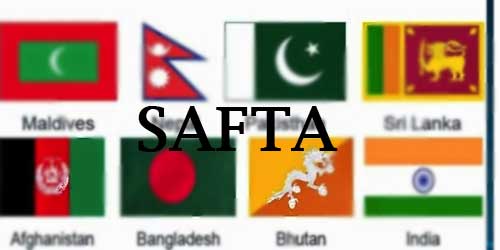

South Asian Free Trade Area (SAFTA) has come into force since January 1, 2006, replacing South Asian Preferential Trade Agreement (SAPTA) which was operative among SAARC countries since December 7, 1995. SAPTA was the success of 9th SAARC conference held in New Delhi in 1995 where this new concessional trade system SAPTA was approved. SAPTA was the factor which really opened all positive possibilities to establish South Asian Free Trade Area.
The most significant aspect of the 12th SAARC
Summit (Jan 4-6, 2004) at Islamabad, the capital city of Pakistan, was the signing of a historic Agreement on Free Trade. The leaders of India, Pakistan, Bangladesh, Bhutan, Maldives, Nepal and Sri Lanka have agreed upon to create a “South Asian Free Trade Area”.
South Asian Free Trade Area (SAFTA) presupposes abolition of all kind of trade and tariff restrictions. Ultimately it will pave the way for the creation of the common market with the common currency.
Seven
SAARC member countries agreed upon to reduce tariff between 0-5% by 2016. The South Asian Free Trade Area (SAFTA) agreement allows any states to pull out of any treaty at any time.
Formation of sensitive lists.
Outlining the products whose tariffs will not be reduced.
Rules of origin.
Revenue lose compensation mechanism for LDCs. (Bangladesh, Bhutan, Maldives and Nepal) by comparatively developed nations (India, Pakistan, and Sri Lanka).
An arbitration council or dispute settlement body.
India and Pakistan will reduce their tariffs 0-5% level within 7 years while Sri Lanka gets 8 years, and LDCs like Nepal, Bangladesh, Bhutan and Maldives in 10 years.
Each of the countries will create two sensitive lists, one of more developed countries and other for less developed countries.
South Asian Free Trade Area (SAFTA) Ministerial council with the membership of commerce/trade ministers.
A committee of Exports for the administration and implementation of the treaty.
Removal of barriers to the infra-SAARC investment, harmonization of the custom facilities transit facilities for infra-SAARC trade and simplification of procedure for the visa.
Also, Read:
21st ASEAN Summit
First-Arctic Summit in Oslo
Fifth BRICS Summit
